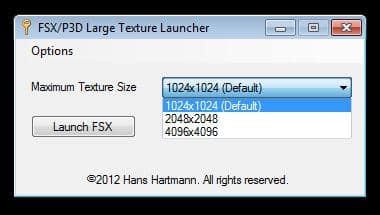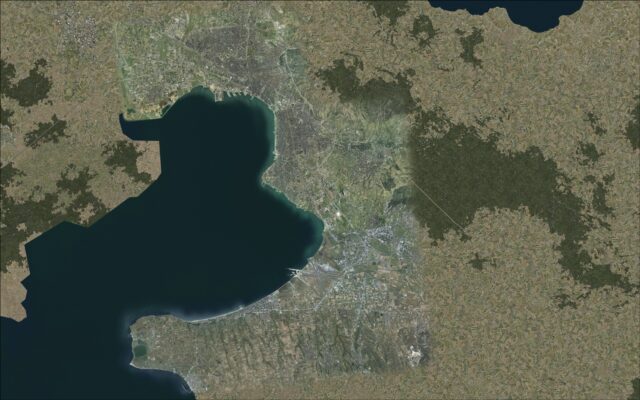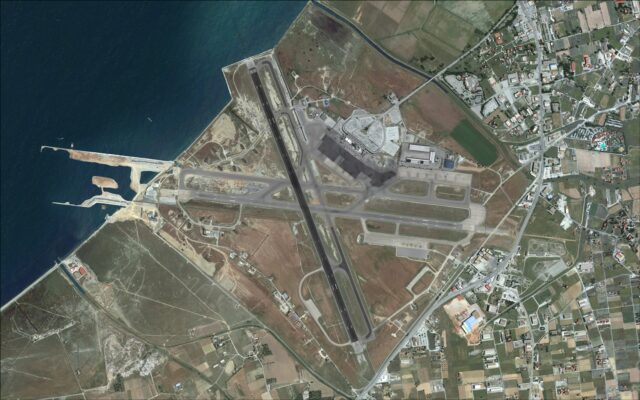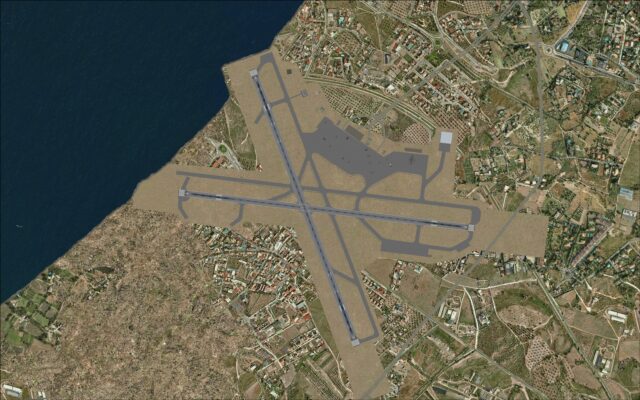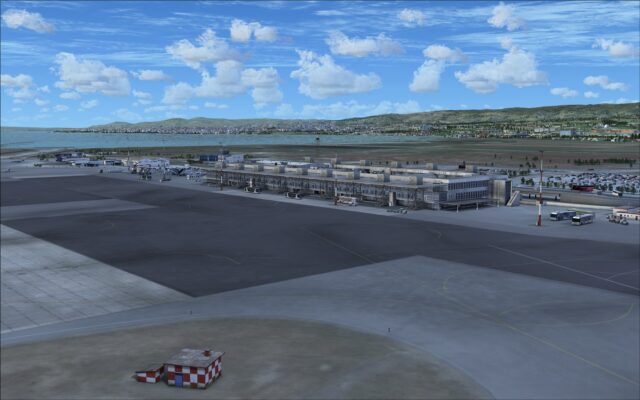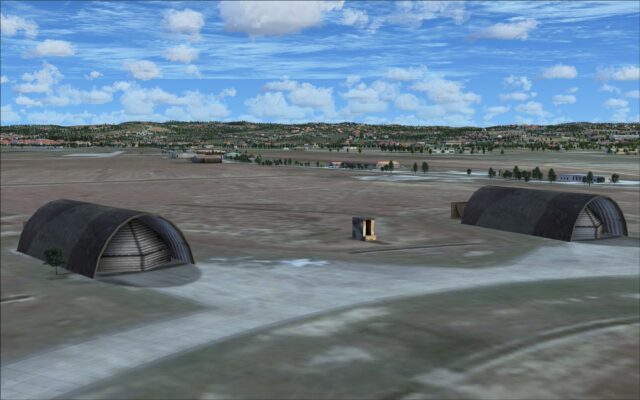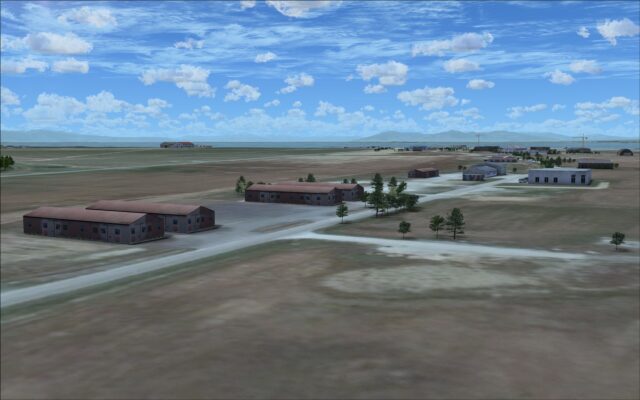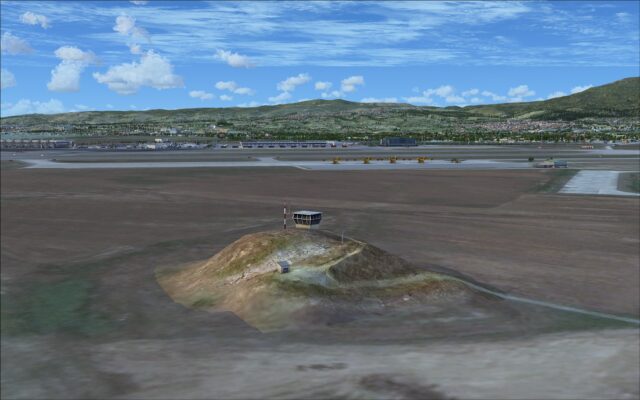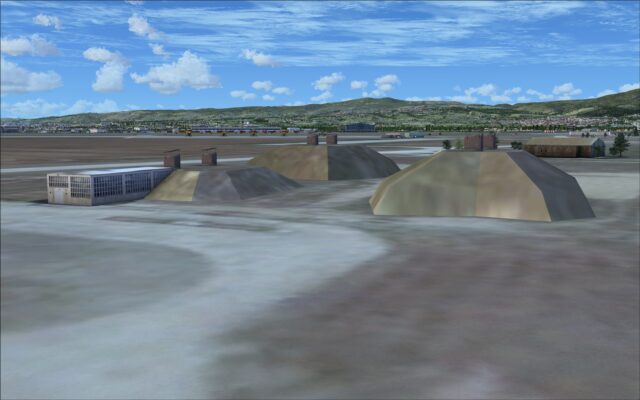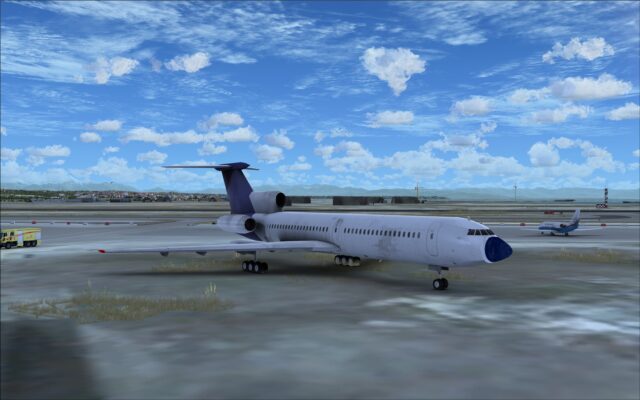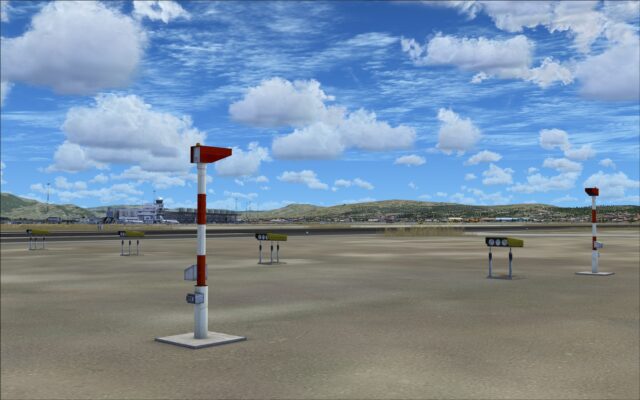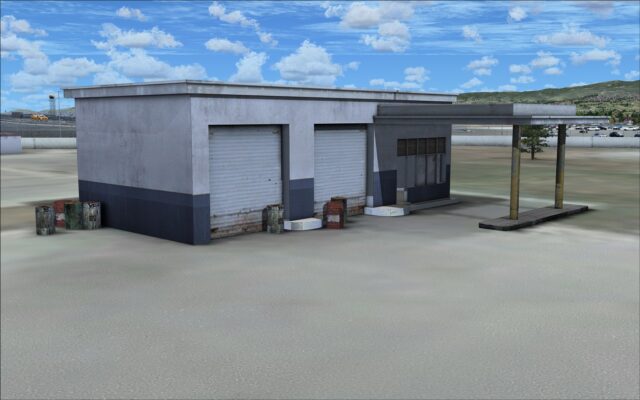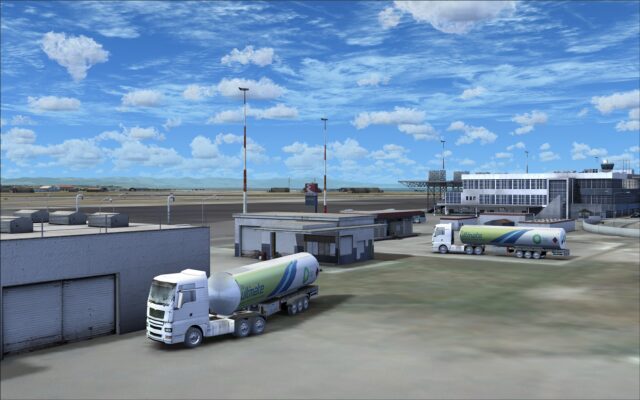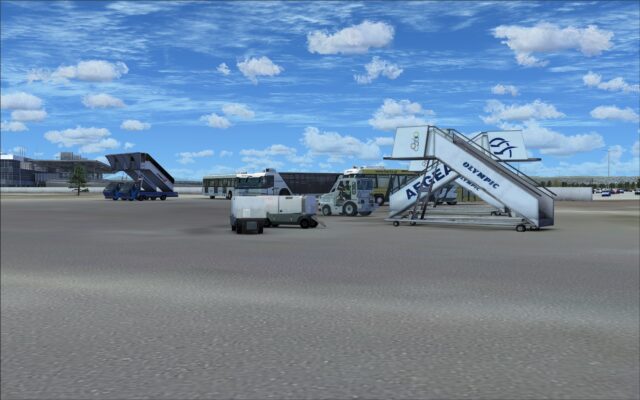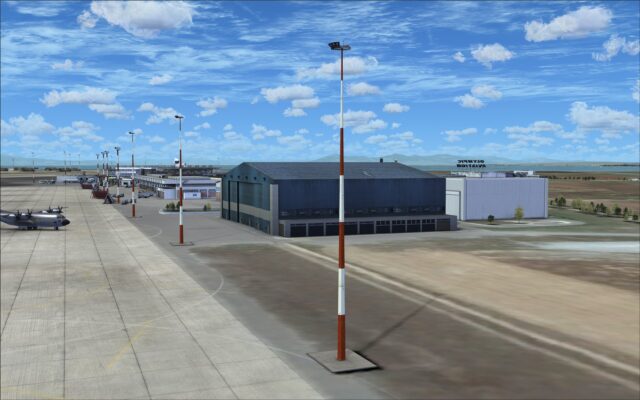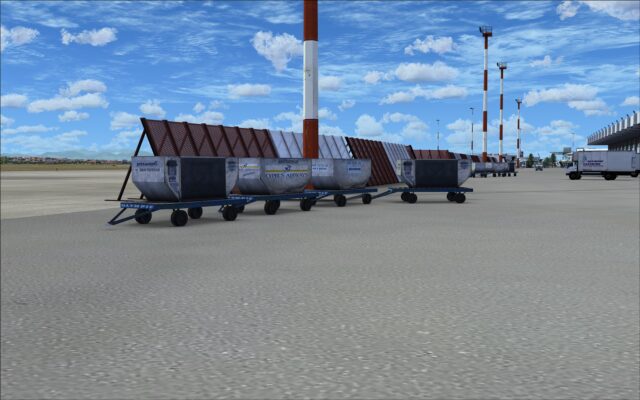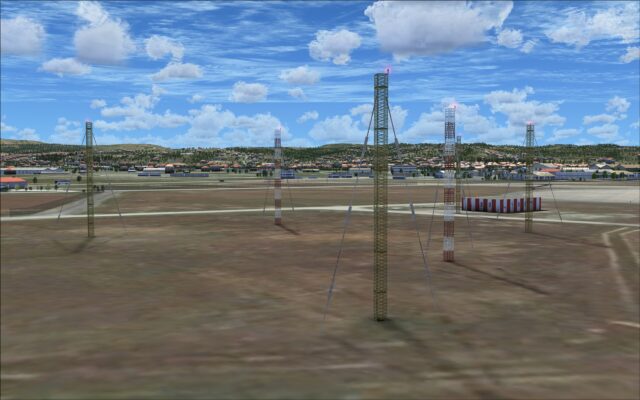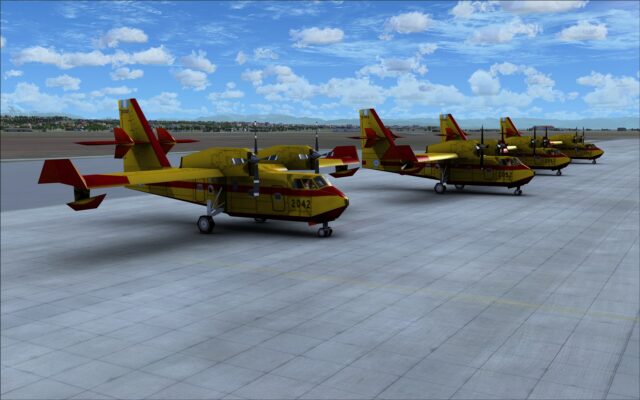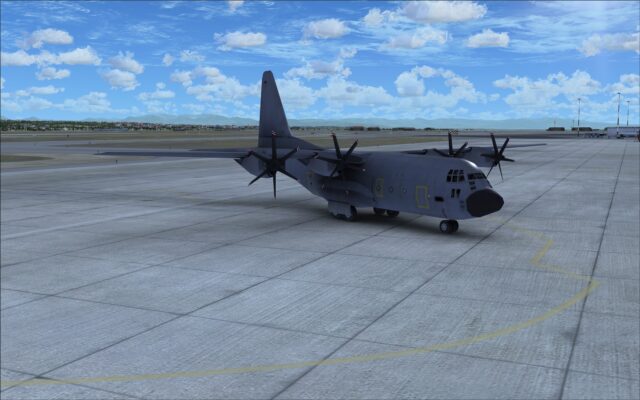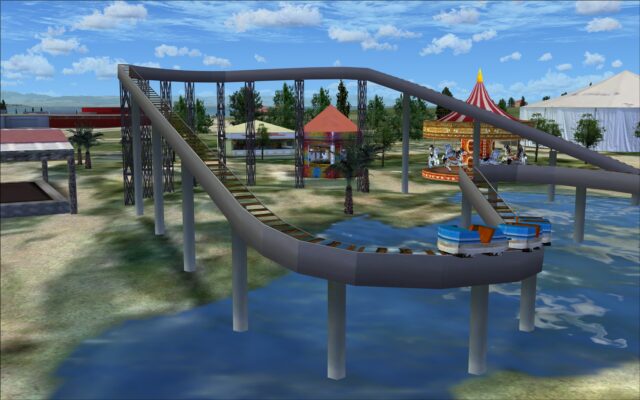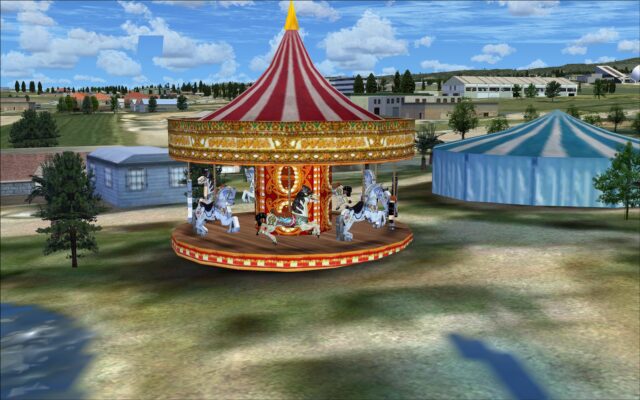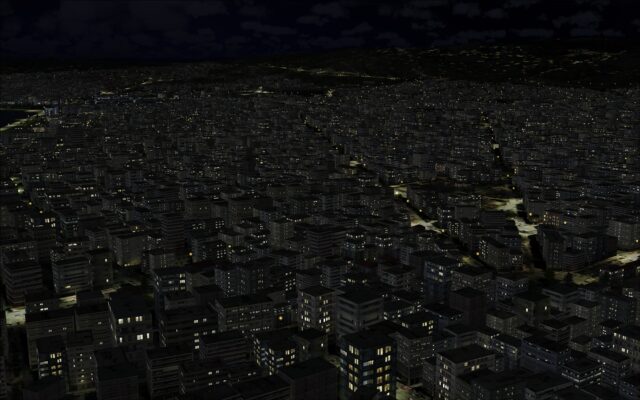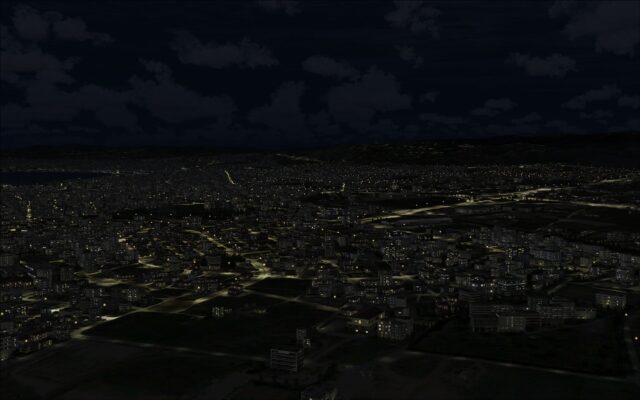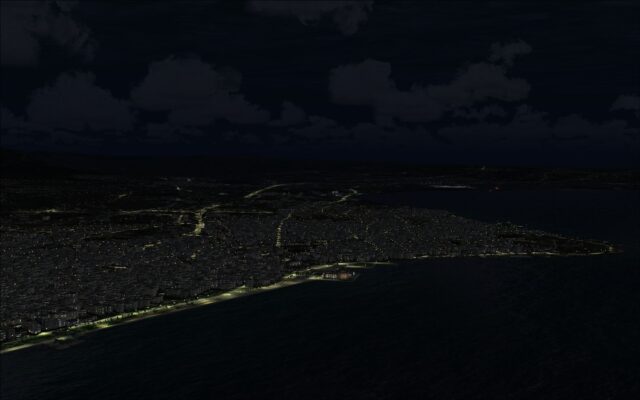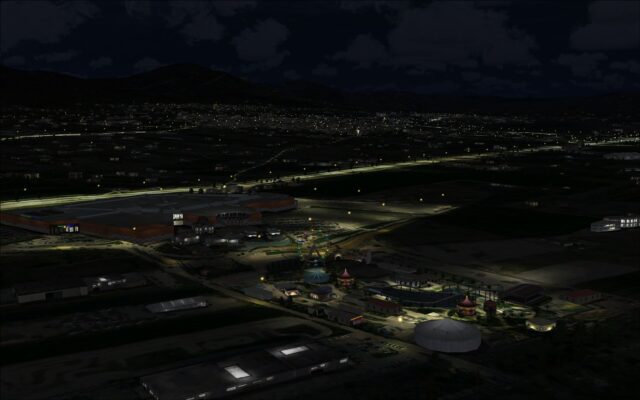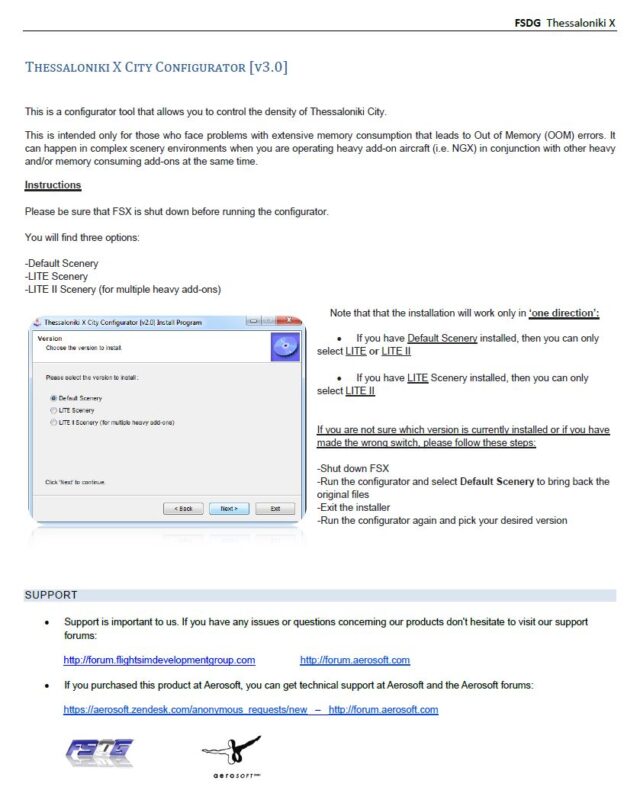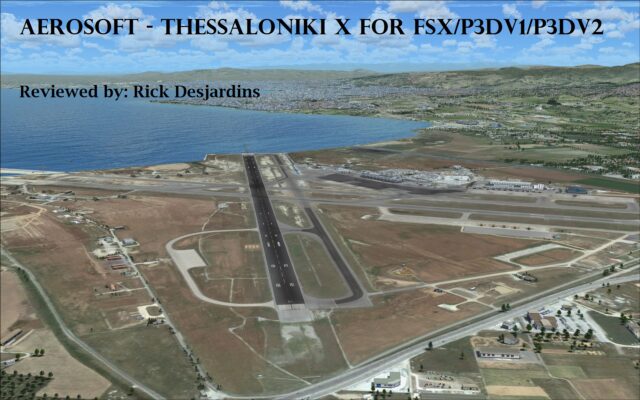
Thessaloniki International Airport, ICAO: LGTS, which is officially known as Macedonia International Airport is located about 15 km SE of the city center of Thessaloniki, Greece. The airport originally opened in 1930 has grown over the years to become the second largest state owned and operated airport in the country after Heraklion airport. In 2012 over 4 million passengers passed through its facilities. The airport is currently in the process of extending runway 10/28 and the scenery depicts the airport in the early stages of this construction.
The nearby city of Thessaloniki which is also extensively modelled in this addon is the second-largest city in Greece and the capital city of the geographic region of Greek Macedonia.
Installation
The installer allows the product to be installed in: FSX, P3DV1 or P3DV2. This appears to be a growing trend and one that is very welcome for many. I installed the product in FSX. The installation process is very simple and only requires you choose your simulator and add your registration information. The installer will do the rest, upon completion you will have three new entries in your FSX scenery library and a new entry in your program group; Aerosoft – Thessaloniki X – FSX. From this menu you can access the various scenery utilities, manual and uninstaller. You are now ready to go.
Documentation
The product comes with a very polished and professional looking 12 page PDF manual. The manual starts off as most do with some general information about the area and airport, it then gets into installation, FSX settings and memory usage, texture resolution and a brief explanation of the configuration utilities and concludes with a page of FAQs. Throughout the manual they’ve included illustrations and hyperlinks that enhance the material being covered in each topic. Even though the product is compatible with P3Dv1 and v2 no mention is made with regards to technical issues like they do for FSX.
Charts were not included with the documentation but can easily be found online.
Configuration
This product includes three configuration utilities; Thessaloniki X Manager, AESLite2 LGTS Thessaloniki X Configuration and LTL.exe. The first two allow you some control over the scenery’s visual features which is good to have with a product as complex as this one. As an example, one of the options you are given is to enable or disable the use of runway 10/28. The manual does explain the options available even though they are basically self-explanatory.


 The third utility, FSX P3D Large Texture Launcher or LTL.exe, lets you set the TEXTURE_MAX_LOAD parameter in the “fsx.cfg” file to one of the three values, 1024, 2048 or 4096. It saves you the effort of setting it manually.
The third utility, FSX P3D Large Texture Launcher or LTL.exe, lets you set the TEXTURE_MAX_LOAD parameter in the “fsx.cfg” file to one of the three values, 1024, 2048 or 4096. It saves you the effort of setting it manually.
This was an airport that had a lot of people waiting anxiously for its release. Greece has benefited from several excellent airport releases from different developers over the past year or so and this one does not disappoint on any level. Everything I look for in a scenery addon I found in this product.
As you can see in the top down screenshots they include much more than simply the airport. The scenery takes in the entire area east and south of the Thermaic Gulf. I’ve also included a top down views of just the airport to compare it with what you get by default in FSX.
Ground textures
Throughout the entire scenery coverage area for both hard surfaces and ground surfaces they use high resolution photo ground textures that are crisp, clear and detailed. To augment the grassy areas they’ve also given you the option of enabling 3d vegetation. The resulting effect is a very realistic experience while on the ground.
Thessaloniki airport has relatively few buildings; the main terminal, cargo facilities and several other miscellaneous structures used for refueling, maintenance, fire station and the Aeroclub in an area north of runway 16/34 and 10/28. The areas to the south of these two runways are mainly used by the military.
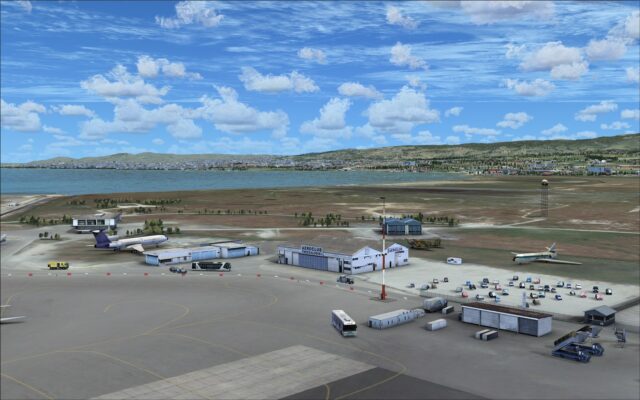
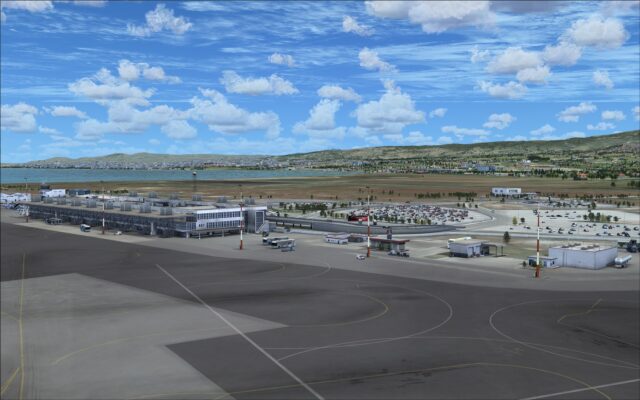
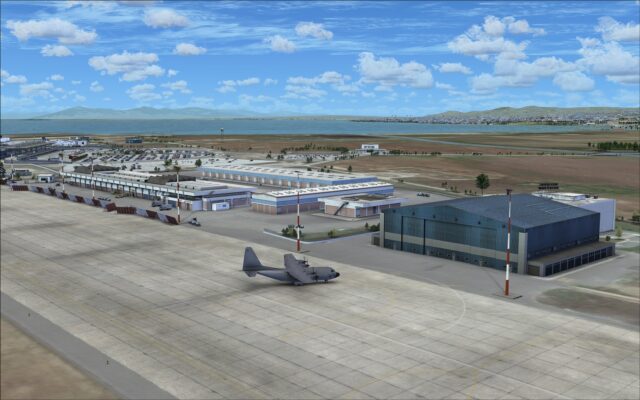
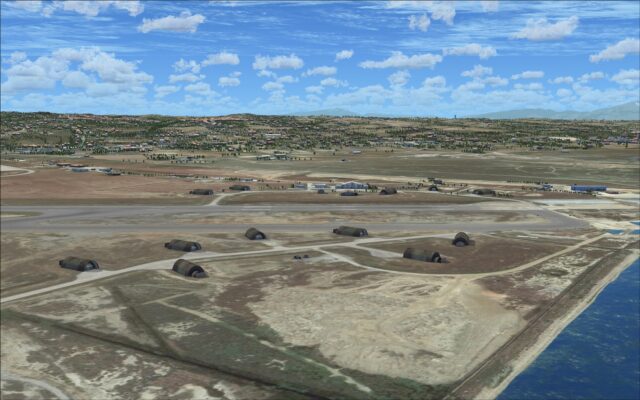 They pulled out all the stops in recreating the airport’s structures. So why do I state that? As you will see they used high resolution images that show all sorts of fine details even when viewed up close plus the colouring techniques allow us to see how weathering and aging affects the different types of building materials. The colouring also helps to accentuate variations in depth giving surfaces a much more pronounced 3d look. Last but definitely not least, extra added details and lots of them.
They pulled out all the stops in recreating the airport’s structures. So why do I state that? As you will see they used high resolution images that show all sorts of fine details even when viewed up close plus the colouring techniques allow us to see how weathering and aging affects the different types of building materials. The colouring also helps to accentuate variations in depth giving surfaces a much more pronounced 3d look. Last but definitely not least, extra added details and lots of them.
The main terminal for me was the major highlight. They put a great deal of work into capturing all of its intricacies and the results are remarkable. There’s no way you can visit this airport and not be impressed by what they’ve done.
The most prominent feature of the structure I believe is the network of exposed metal bracing used to support the metal roof overhangs. These overhangs extend the entire length of both the apron side and arrivals side of the building. The amount of work that went into the modelling of this intricate web of metal beams must have been extreme. I especially loved how it looked from the vantage point of sitting in an aircraft cockpit. But having said that it looked great from any distance or angle. If you look past this feature you will see that they’ve taken a great deal of care in also modelling the multiple stairways that lead from the ground level to the second floor. The metal railings and glass panels along with being able to distinguish individual tiles on the stair treads is impressive and the attention to detail doesn’t stop there. Underneath the main structure they’ve added the baggage conveyors and included the start/stop buttons that control the belts movements. This is just a short list of what they’ve included.
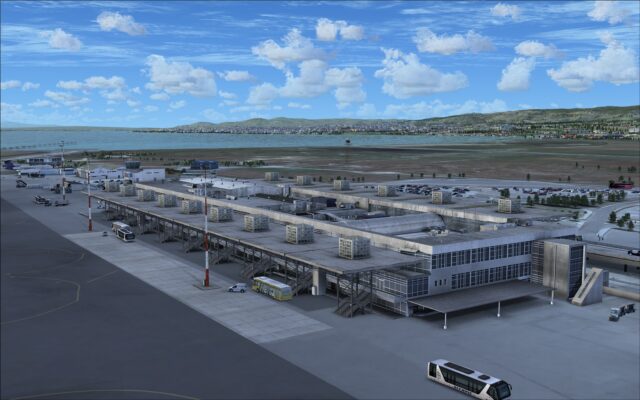
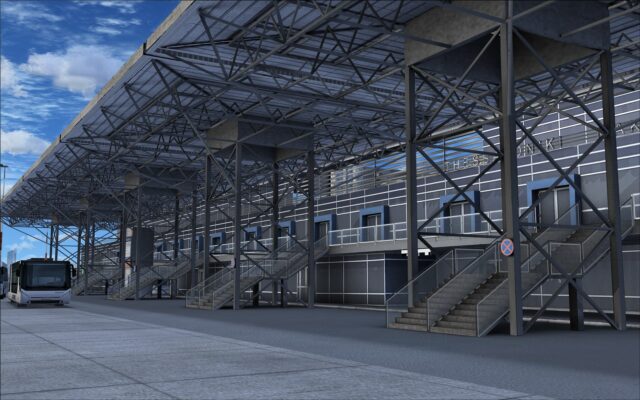
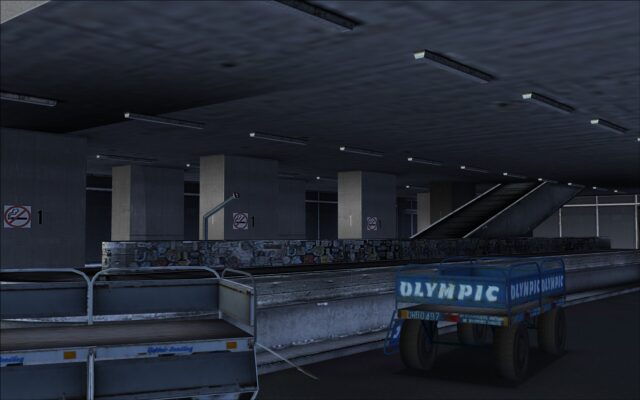
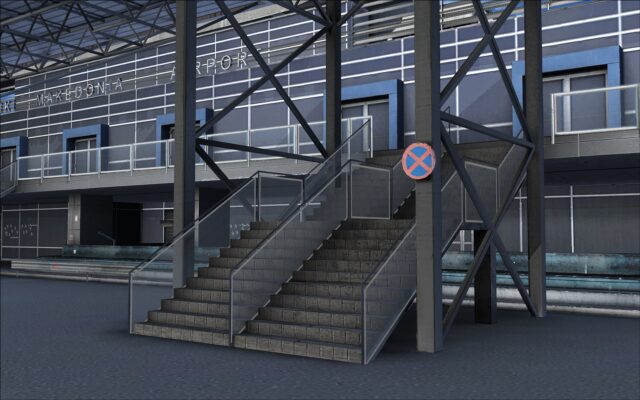 If you move around to the arrivals side we can admire some of the same visual enhancements as I just mentioned for the apron side with regards to the network of metal supports. In addition, there are glass encased walkways, road guard rails and several different types of street and building signage.
If you move around to the arrivals side we can admire some of the same visual enhancements as I just mentioned for the apron side with regards to the network of metal supports. In addition, there are glass encased walkways, road guard rails and several different types of street and building signage.
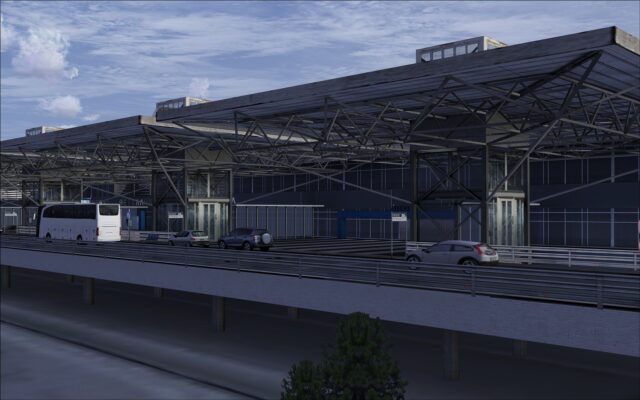
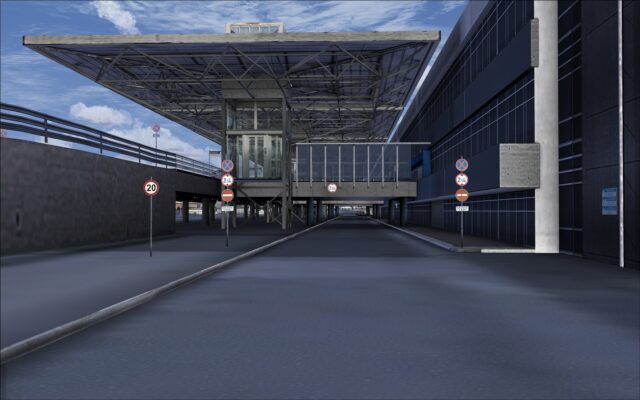 While pointing out the enhancements to this side of the building I think that it would be a good time to also point out what they’ve done to enhance the area directly in front of the building as well. The parking lot, entrance roadway and ramp are impressive; the area is populated with shrubbery, signage and the parking lot filled with cars, trucks and buses.
While pointing out the enhancements to this side of the building I think that it would be a good time to also point out what they’ve done to enhance the area directly in front of the building as well. The parking lot, entrance roadway and ramp are impressive; the area is populated with shrubbery, signage and the parking lot filled with cars, trucks and buses.
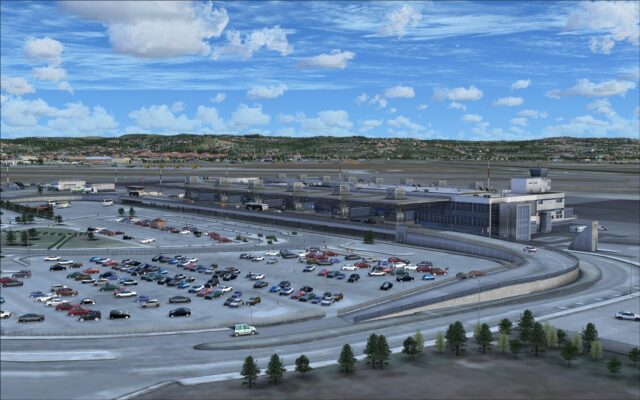
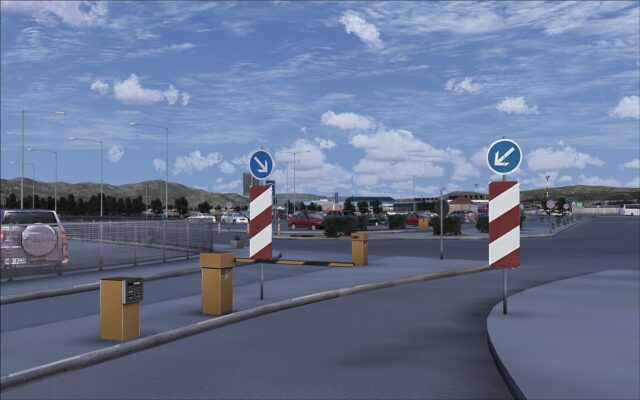
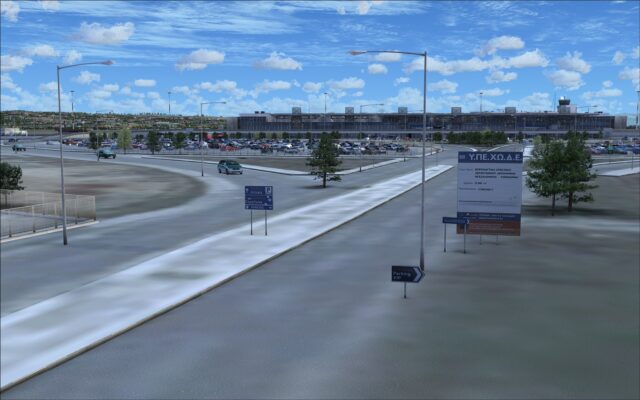 Building roof tops are often overlooked or given a minimal amount of attention but not here. It definitely deserves to be mentioned and seeing the screenshots will show why. The level of intricate detailing is outstanding!
Building roof tops are often overlooked or given a minimal amount of attention but not here. It definitely deserves to be mentioned and seeing the screenshots will show why. The level of intricate detailing is outstanding!
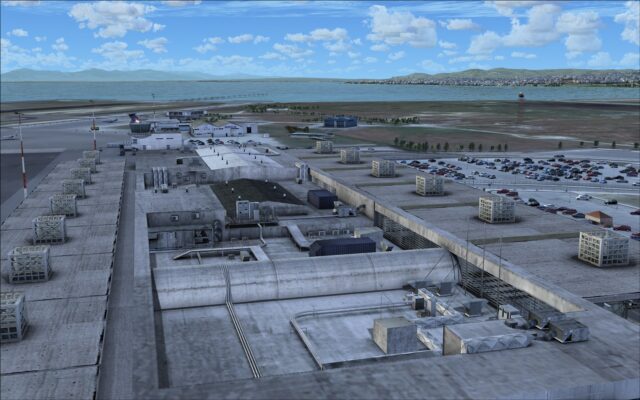
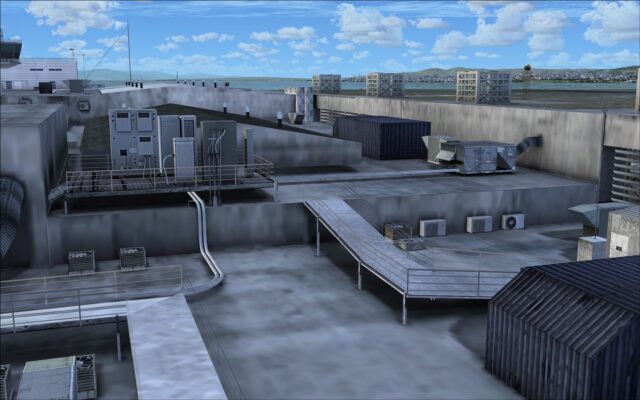
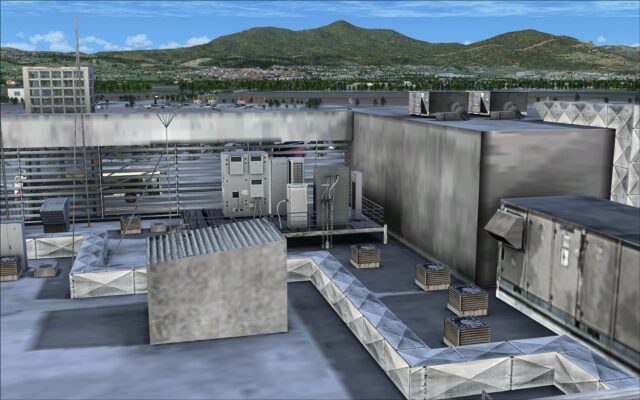 Moving on to the other structures it was obvious that their dedication to providing a top notch experience went way beyond the terminal. They employed all of the same techniques in the other buildings. Size didn’t matter here, each one was meticulously recreated. As an example, looking at the DHL building check out the water downspouts.
Moving on to the other structures it was obvious that their dedication to providing a top notch experience went way beyond the terminal. They employed all of the same techniques in the other buildings. Size didn’t matter here, each one was meticulously recreated. As an example, looking at the DHL building check out the water downspouts.
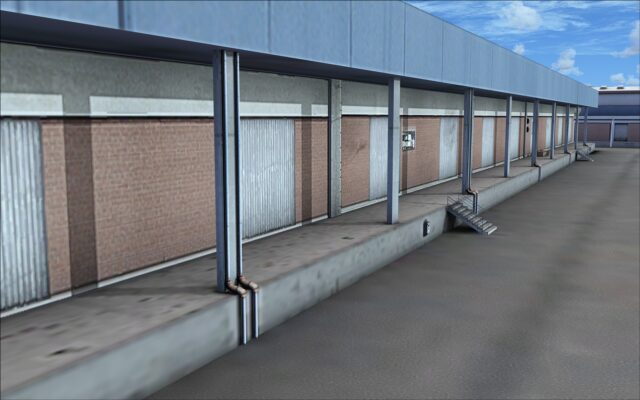
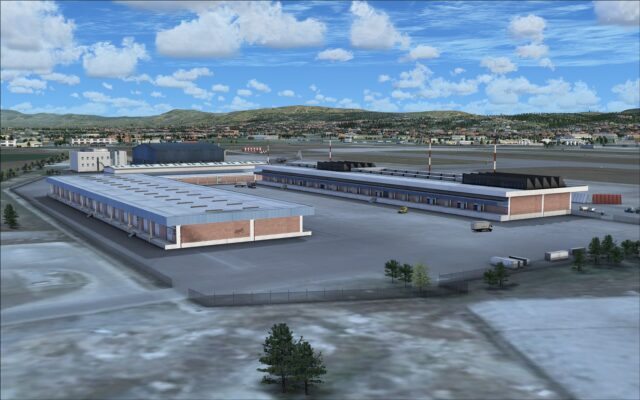
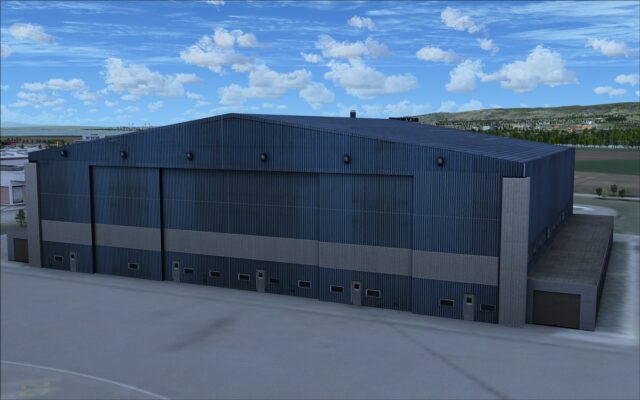
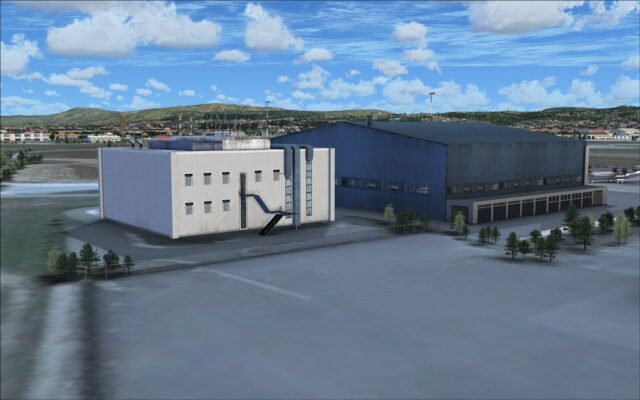
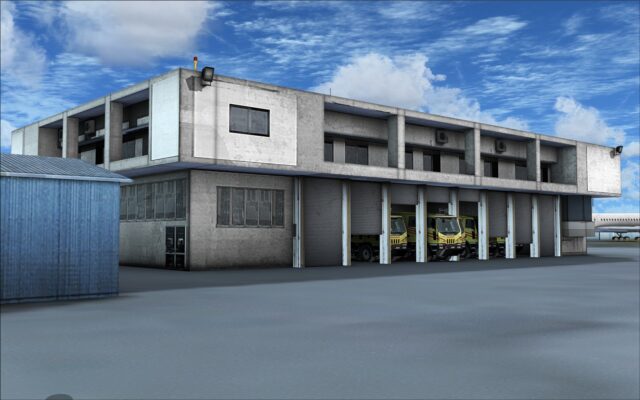
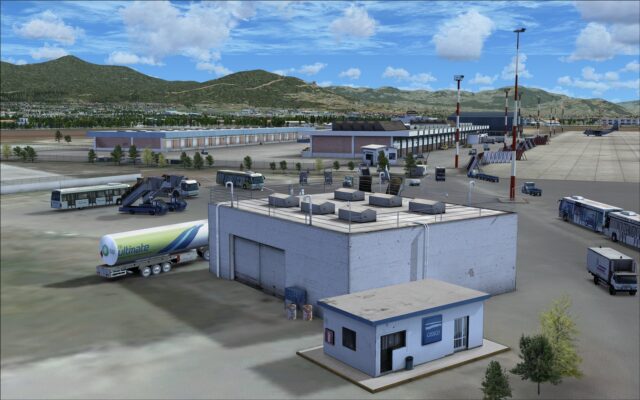
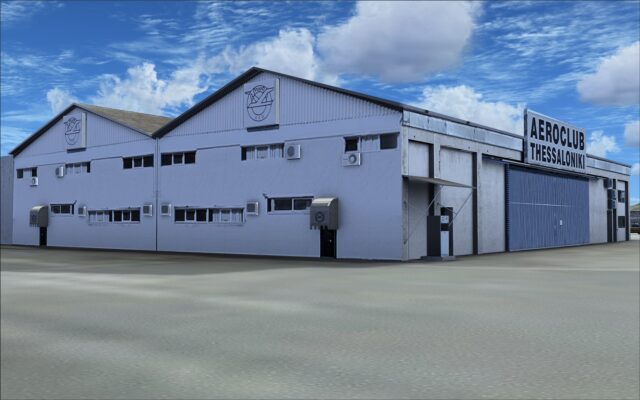 The airport also has a military element. Located primarily on the south side of runway 10/28 there are hardened aircraft shelters, ammunition bunkers and a variety of other miscellaneous buildings. No mistaking that they are military just look at their distinct design and paint schemes.
The airport also has a military element. Located primarily on the south side of runway 10/28 there are hardened aircraft shelters, ammunition bunkers and a variety of other miscellaneous buildings. No mistaking that they are military just look at their distinct design and paint schemes.
Of course a big part of making an airport look real depends on how well they populate it with everything needed to allow an airport to function on a daily basis. They’ve succeeded in doing just that, populating the entire airport with high quality objects and vehicles. It’s been done in such a way that we can become immersed in the environment and activities that take place. Realistic is the word that kept coming into my head over and over as I spent time at Thessaloniki airport. The other thing about their work is that many details are subtle. As an example they include small details such as tires and rims up against a wall, or boxes near a doorway. It’s often these little touches, the nuances that make the difference.
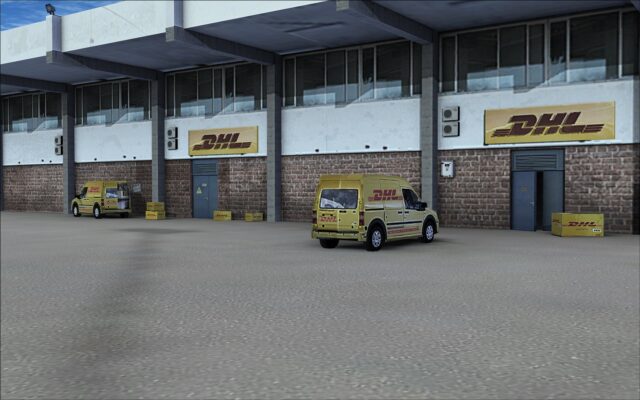
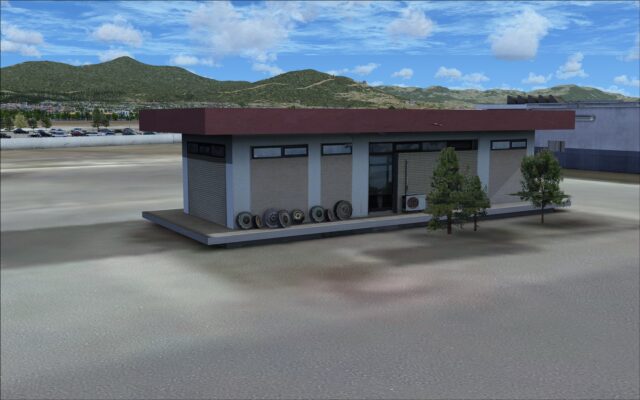 An added visual treat was their inclusion of some high quality static aircraft. They’ve included both civilian and military aircraft and have them placed to enhance the experience while not interfering with programs such as UT2 that add AI aircraft to airports.
An added visual treat was their inclusion of some high quality static aircraft. They’ve included both civilian and military aircraft and have them placed to enhance the experience while not interfering with programs such as UT2 that add AI aircraft to airports.
The scenery includes a number of subtle animations. Vehicular traffic both at the airport and on the nearby roadways is the predominant one. On the airport apron and service roads we see the usual array of service vehicles travelling around which is pretty standard stuff. On the roads just outside the airport and leading up to the terminal building there is a nice variety of personal and commercial vehicles as well. The quality of all of these vehicles is very good.
Other animations include the control tower with a rotating radar and light beacon.
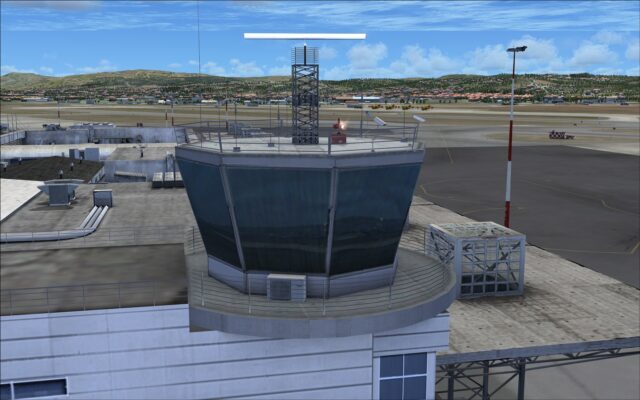 With a flair for adding something different there is an AI helicopter that can be seen flying around in the vicinity of the construction zone at the of runway 10.
With a flair for adding something different there is an AI helicopter that can be seen flying around in the vicinity of the construction zone at the of runway 10.
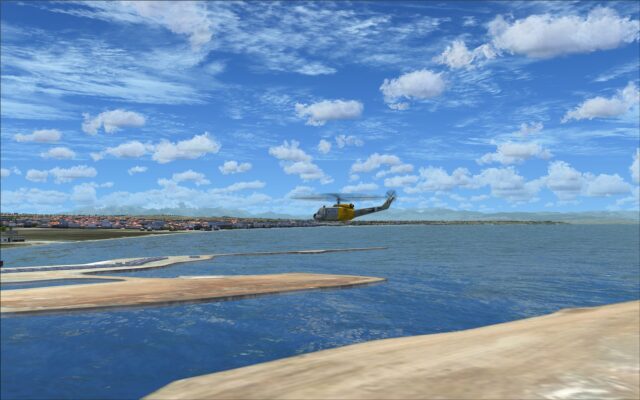 While on the subject of different animations, the city of Thessaloniki has an amusement park named Magic Park. The park has been recreated in detail and they’ve included moving rides such as a roller coaster and merry-go-round.
While on the subject of different animations, the city of Thessaloniki has an amusement park named Magic Park. The park has been recreated in detail and they’ve included moving rides such as a roller coaster and merry-go-round.
Often times developers will include an area near the airport to up the visual experience while on approach or departure. They might include photo ground textures and then populate the area with buildings. This group has done that and more. What they’ve done is model the area bordering the Thermaic Gulf to include the city of Thessaloniki of course and the neighbouring suburbs of Kalamaria, Evosmos and Kalochon. The entire area is covered in high resolution photo ground textures and populated with thousands of objects, many of them being custom; the results are stunning. Custom structures are everywhere and they are detailed. They include sports facilities, shopping centers, historical sites, the university, Thessaloniki Observatory, an amusement park, the Port of Thessaloniki and the OTE Tower and on and on. Flying over the city and surroundings just doesn’t get old. Coming in for final approach to runway 16 was amazing.
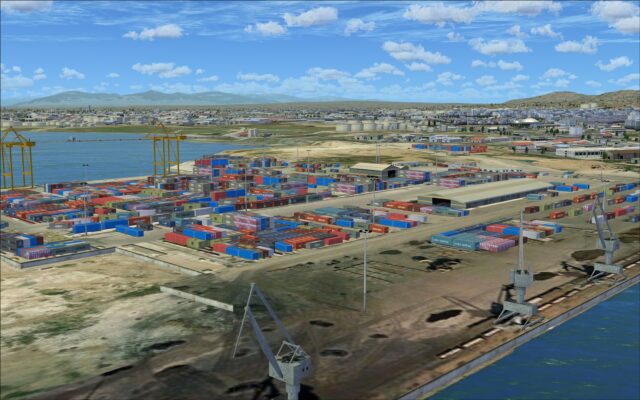
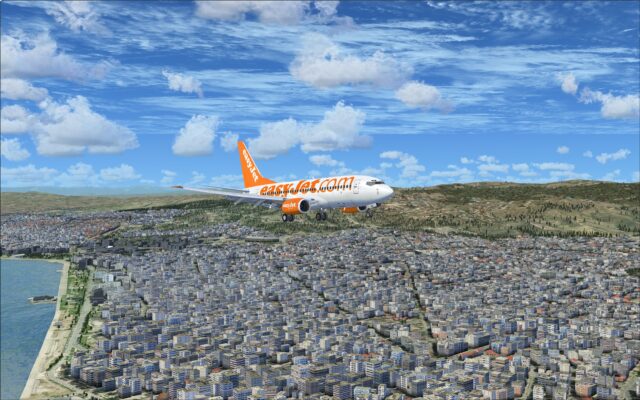
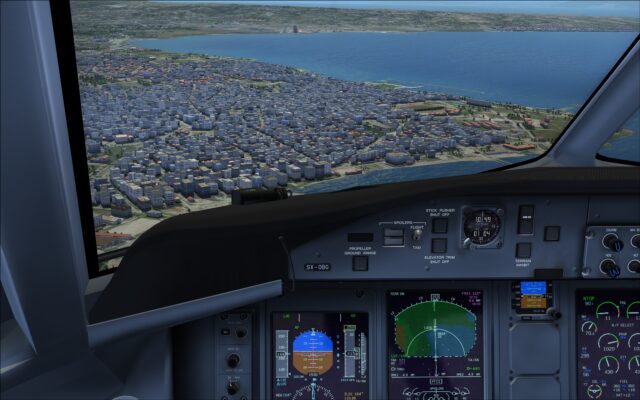
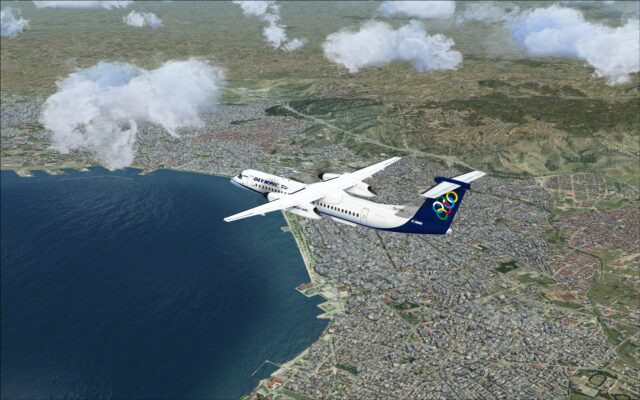
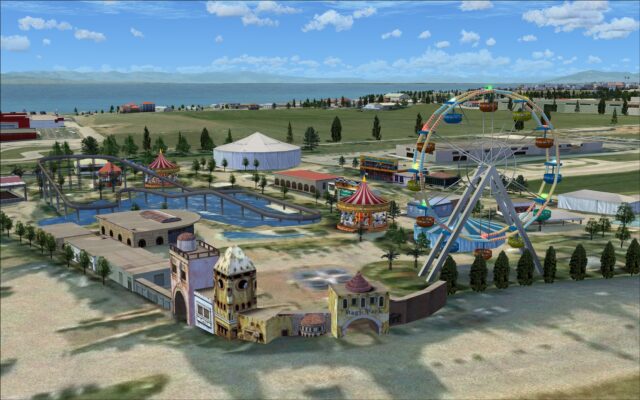
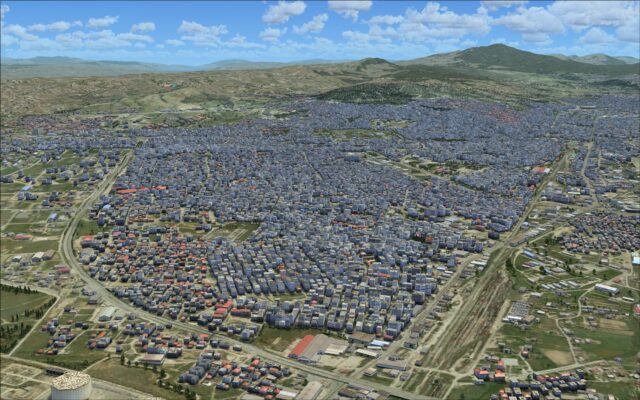
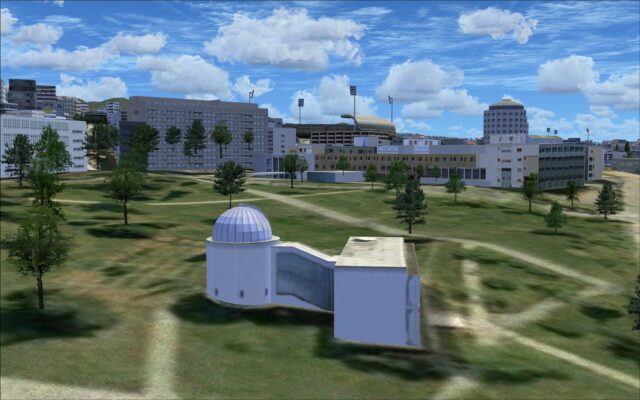
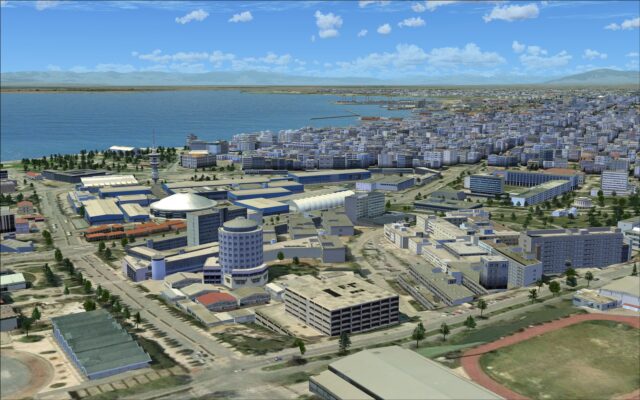
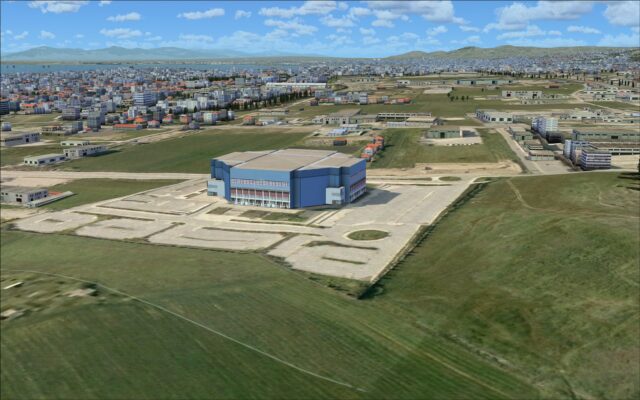
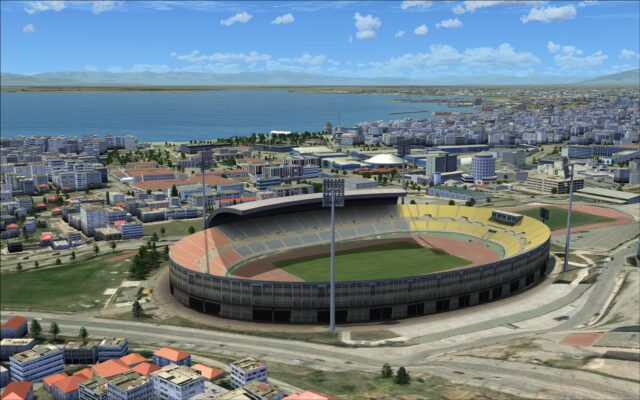
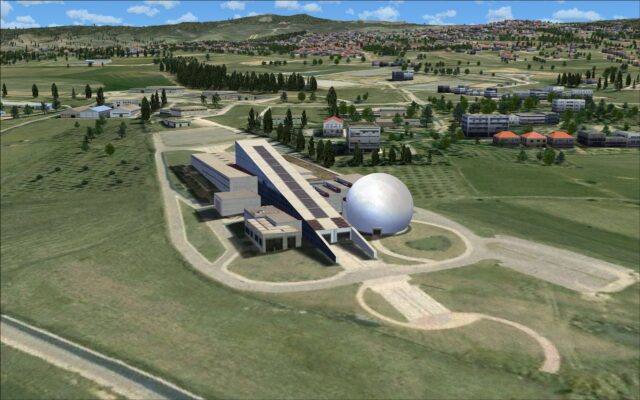
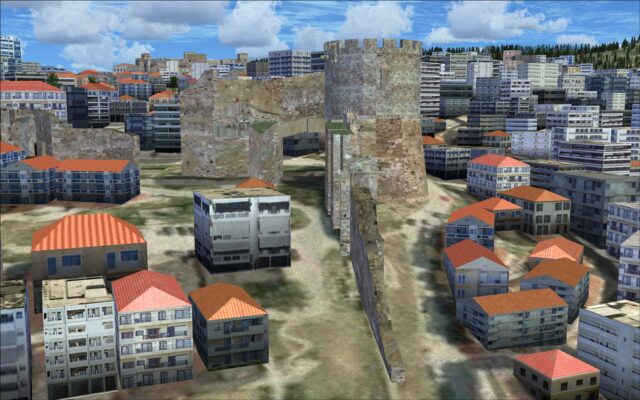
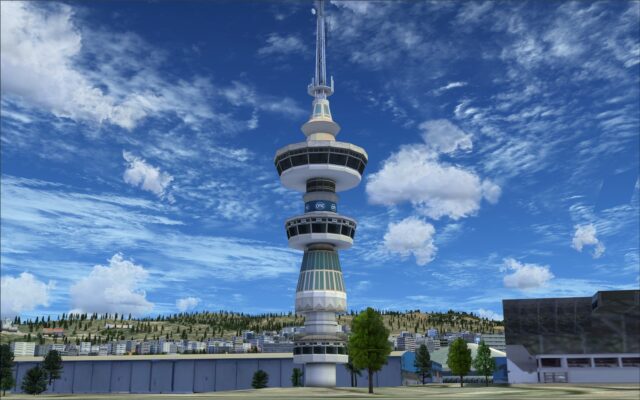
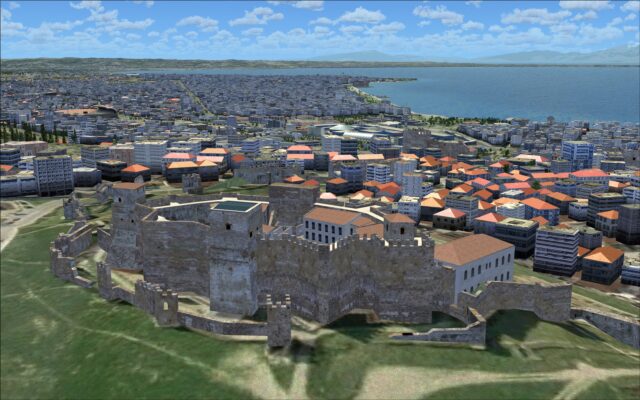
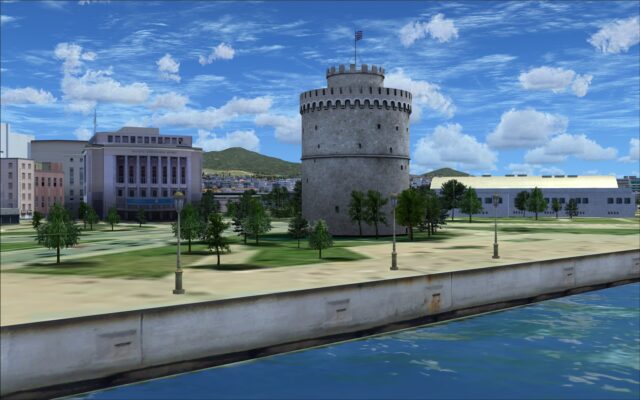 The only downside to all of this is that if you are going to run into memory issues this is likely where you will experience them.
The only downside to all of this is that if you are going to run into memory issues this is likely where you will experience them.
Night
Experiencing Thessaloniki at night was definitely another product highlight. The ambiance and immersion factor of the entire package was just as impressive as it was during daylight hours.
A huge part of any night time experience are the different types of lighting and how they are depicted and implemented. Building lighting both internal and external, apron lighting, approach/taxiway and runway lighting are the most common; all were extremely well done. Some factors that made the lighting appear realistic were the subtle differences in light intensity and how the light illuminated the different surfaces.
Runways/taxiways/aprons are a great area to look at night lighting because there are so many different types of lights used. From the lighting of the runway/taxiway markers, PAPI lights, elevated lights, inset lights, etc each has its own unique features and projects light in a slightly different way and those characteristics were portrayed vary convincingly. Here are a few screenshots that highlight this aspect of their work. Notice in the two-part screenshot how the yellow light cast on the ground follows the light in the fixture. The same screenshots also show how the runway marker is casting a glow on the ground directly in front of the sign.
 Inset lighting was another different type of lighting that they did very realistically. You’ll note in this screenshot how the light can be seen shining out from the opening and not from the entire fixture as they are usually depicted.
Inset lighting was another different type of lighting that they did very realistically. You’ll note in this screenshot how the light can be seen shining out from the opening and not from the entire fixture as they are usually depicted.
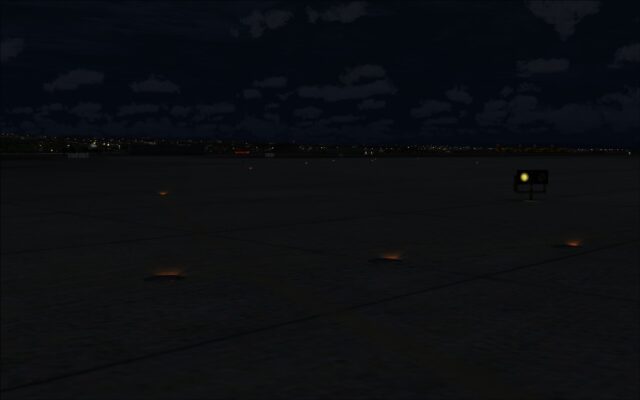 Another feature of their night lighting had to do with exterior building lighting. These next few screenshots show how the intensity at the wall mounted fixture is so much more pronounced than the light that is projected on to the nearby surfaces. The same effect can be seen with obstruction lights.
Another feature of their night lighting had to do with exterior building lighting. These next few screenshots show how the intensity at the wall mounted fixture is so much more pronounced than the light that is projected on to the nearby surfaces. The same effect can be seen with obstruction lights.
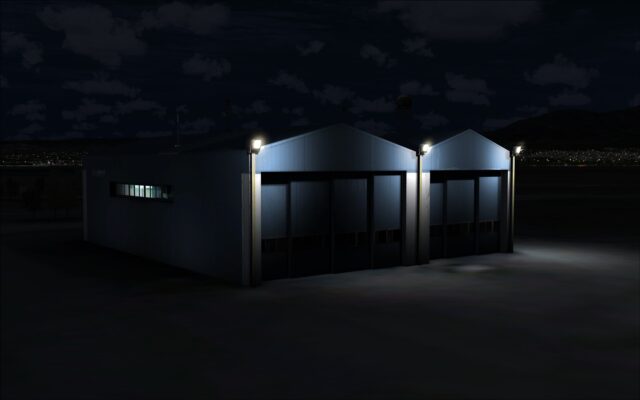
 Here are several more screenshots to show off their work in other parts of the airport. These include apron lighting and some showing off interior and exterior building lighting.
Here are several more screenshots to show off their work in other parts of the airport. These include apron lighting and some showing off interior and exterior building lighting.
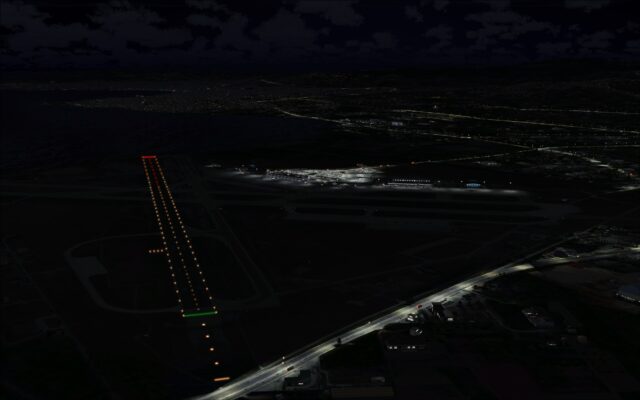
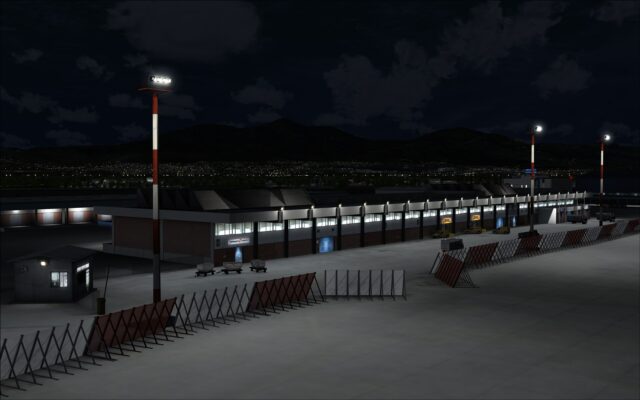
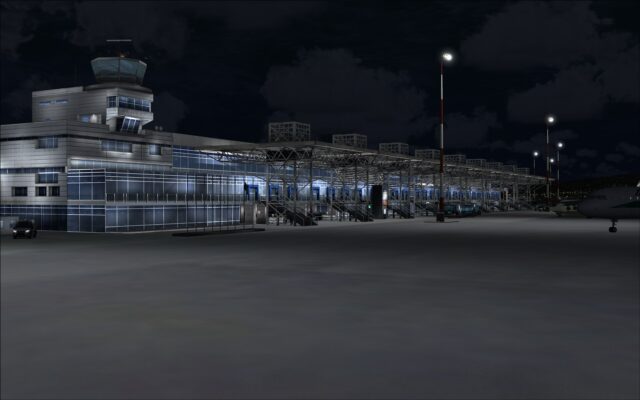
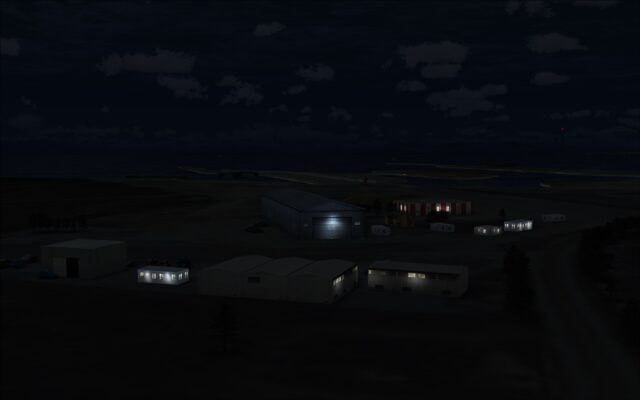
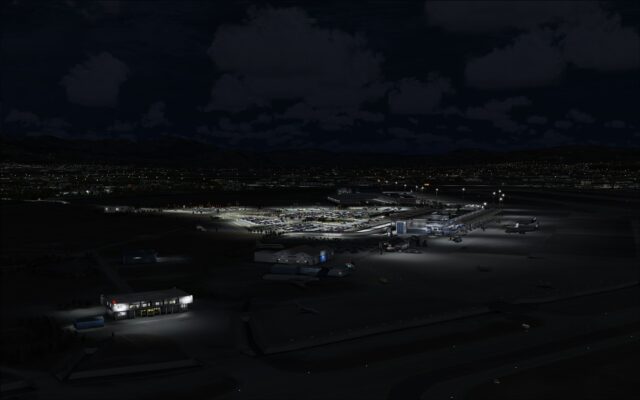
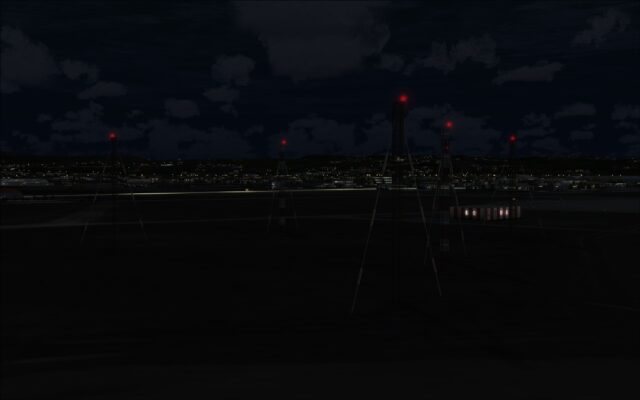
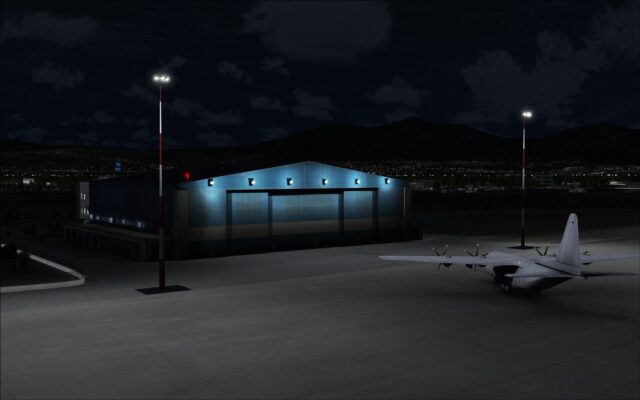
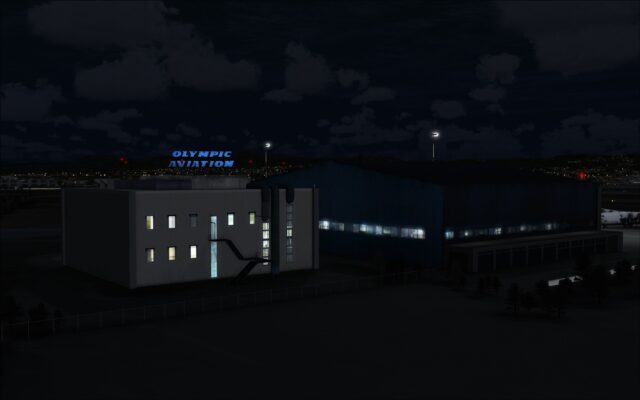 Looking at the city of Thessaloniki and its surroundings we see buildings that are lit up, the 3d light effects from street lighting and then the ground illumination. All of these combined make for a very lifelike environment. A perfect companion to the outstanding job they did with the airport.
Looking at the city of Thessaloniki and its surroundings we see buildings that are lit up, the 3d light effects from street lighting and then the ground illumination. All of these combined make for a very lifelike environment. A perfect companion to the outstanding job they did with the airport.
Whenever you have a scenery that is as complex as this one you invariably experience or hear of other users that have performance and memory issues. This is where the included configuration utilities can come in real handy. In my set up I ran all sliders fully to the right and left all the features enabled. When I did my first approach in a PMDG 737NGX I fell victim to the dreaded OOM. Not wanting to reduce the visuals I kept all my FSX settings the same and all scenery features enabled and ran the “FSX P3D Large Texture Launcher or LTL.exe” utility setting the texture size to 2048 vice 4096. I could have manually edited the FSX Texture load setting rather than have the utility do it but I wanted to see it work. The results, no apparent compromises to visual quality and I have not experienced a single OOM error since and that was while flying with the PMDG 737NGX and Majestic Dash 8 Q400. Having said that, everyone’s situation will be different but this scenery is definitely worth the effort of finding that sweet spot.
Since beginning my review the developers have released the THESSALONIKI X CITY CONFIGURATOR [V3.0] which works to alleviate any OOM problems. Their work in this regard speaks to the dedication they have to customer satisfaction.
If you are any kind of flight sim enthusiast you will definitely, without a doubt want to purchase this product. It is easy to see that the developers were very passionate about what they were creating; it shows in the quality of the finished product. I absolutely loved everything about Thessaloniki X and if I could give a product a gold star I would definitely award it to this product.
My Ratings
Installer: Very good.
Documentation: Very good. Well written however little is mentioned about P3D. No charts were included.
Modelling: Very good. They have taken this to the extreme.
Extras: Very good. Extensive modelling of surrounding area including many detailed custom objects. Several configuration utilities also included to help optimize addon for individual needs.
Download Size: FSX 952Mb
Price: EUR 20.97 without VAT
Developer Homepage: http://www.aerosoft.de
Link http://secure.simmarket.com/aerosoft-thessaloniki-x-(download).phtml
Test System:
Intel i7 960 OC @ 4.2 Ghz, 6 Gb RAM, Gigabyte GTX780 w3Gb video, Win 7 Ultimate 64, FSX w/acceleration, DX9, UT2, REX Overdrive, GEXn, UTX, AES, GSX, FSUIPC.
Richard Desjardins


